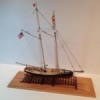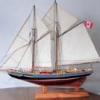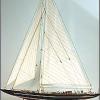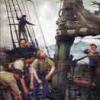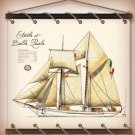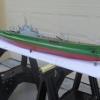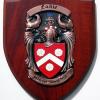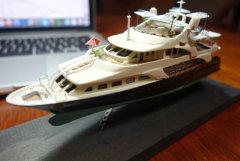MORE HANDBOOKS ARE ON THEIR WAY! We will let you know when they get here.
×
-
Posts
818 -
Joined
-
Last visited
Reputation Activity
-
 _SalD_ got a reaction from CharlieZardoz in US Brig Syren by _SalD_ – FINISHED - 3/16" scale
_SalD_ got a reaction from CharlieZardoz in US Brig Syren by _SalD_ – FINISHED - 3/16" scale
I was a little disappointed in the way I finished the deck and I learned what not to do next time. I drilled all the holes for the treenails prior to staining the deck which in hind sight I don’t think was a good idea. Prior to staining the deck I stained a test strip with holes in it similar to the deck and found that the stain was bleeding into the holes making a dark ring at each hole. To avoid this I filled all the holes with wood filler before staining. There was no bleeding into the holes but the stain was a little blotchy (yes Augie I tried pre-stain this time). I believe it was from not sanding the deck enough to remove all the wood filler that was on the surface. I was a little reluctant to sand too much in fear of sanding through the deck plank but again in hind sight there was plenty of material left to sand.
For the treenails I decided to show only the treenails located along the deck beams where I had a butt joint and not at every beam between the bulkheads. I thought it would be too much, not to mention I didn’t want to drill all those holes. The only problem was that after I filled them with wood filler and stained the deck the treenails didn’t show up too well. I may redo them.
For the waterway I tried a few different procedures to make the triangular chamfer strip from the 1/16” square stock. There is probably a real simple way of doing this but what I came up with was; first I cut a V-groove in a piece of scrap pine using a V gouge, making the depth of the groove slightly less than the finished shape of the waterway. Next I taped two erasing shields on either side of the groove to avoid sanding into the pine. The shields are 0.1 mm thick. Then I laid the wood strip in the groove and removed the top half using my dremel’s drum sanding attachment. What was left was a nice 1/16” X 1/16” chamfer strip.
-
 _SalD_ got a reaction from canoe21 in US Brig Syren by _SalD_ – FINISHED - 3/16" scale
_SalD_ got a reaction from canoe21 in US Brig Syren by _SalD_ – FINISHED - 3/16" scale
I was a little disappointed in the way I finished the deck and I learned what not to do next time. I drilled all the holes for the treenails prior to staining the deck which in hind sight I don’t think was a good idea. Prior to staining the deck I stained a test strip with holes in it similar to the deck and found that the stain was bleeding into the holes making a dark ring at each hole. To avoid this I filled all the holes with wood filler before staining. There was no bleeding into the holes but the stain was a little blotchy (yes Augie I tried pre-stain this time). I believe it was from not sanding the deck enough to remove all the wood filler that was on the surface. I was a little reluctant to sand too much in fear of sanding through the deck plank but again in hind sight there was plenty of material left to sand.
For the treenails I decided to show only the treenails located along the deck beams where I had a butt joint and not at every beam between the bulkheads. I thought it would be too much, not to mention I didn’t want to drill all those holes. The only problem was that after I filled them with wood filler and stained the deck the treenails didn’t show up too well. I may redo them.
For the waterway I tried a few different procedures to make the triangular chamfer strip from the 1/16” square stock. There is probably a real simple way of doing this but what I came up with was; first I cut a V-groove in a piece of scrap pine using a V gouge, making the depth of the groove slightly less than the finished shape of the waterway. Next I taped two erasing shields on either side of the groove to avoid sanding into the pine. The shields are 0.1 mm thick. Then I laid the wood strip in the groove and removed the top half using my dremel’s drum sanding attachment. What was left was a nice 1/16” X 1/16” chamfer strip.
-
 _SalD_ got a reaction from jdbradford in US Brig Syren by _SalD_ – FINISHED - 3/16" scale
_SalD_ got a reaction from jdbradford in US Brig Syren by _SalD_ – FINISHED - 3/16" scale
I was a little disappointed in the way I finished the deck and I learned what not to do next time. I drilled all the holes for the treenails prior to staining the deck which in hind sight I don’t think was a good idea. Prior to staining the deck I stained a test strip with holes in it similar to the deck and found that the stain was bleeding into the holes making a dark ring at each hole. To avoid this I filled all the holes with wood filler before staining. There was no bleeding into the holes but the stain was a little blotchy (yes Augie I tried pre-stain this time). I believe it was from not sanding the deck enough to remove all the wood filler that was on the surface. I was a little reluctant to sand too much in fear of sanding through the deck plank but again in hind sight there was plenty of material left to sand.
For the treenails I decided to show only the treenails located along the deck beams where I had a butt joint and not at every beam between the bulkheads. I thought it would be too much, not to mention I didn’t want to drill all those holes. The only problem was that after I filled them with wood filler and stained the deck the treenails didn’t show up too well. I may redo them.
For the waterway I tried a few different procedures to make the triangular chamfer strip from the 1/16” square stock. There is probably a real simple way of doing this but what I came up with was; first I cut a V-groove in a piece of scrap pine using a V gouge, making the depth of the groove slightly less than the finished shape of the waterway. Next I taped two erasing shields on either side of the groove to avoid sanding into the pine. The shields are 0.1 mm thick. Then I laid the wood strip in the groove and removed the top half using my dremel’s drum sanding attachment. What was left was a nice 1/16” X 1/16” chamfer strip.
-
 _SalD_ got a reaction from tarbrush in US Brig Syren by _SalD_ – FINISHED - 3/16" scale
_SalD_ got a reaction from tarbrush in US Brig Syren by _SalD_ – FINISHED - 3/16" scale
I was a little disappointed in the way I finished the deck and I learned what not to do next time. I drilled all the holes for the treenails prior to staining the deck which in hind sight I don’t think was a good idea. Prior to staining the deck I stained a test strip with holes in it similar to the deck and found that the stain was bleeding into the holes making a dark ring at each hole. To avoid this I filled all the holes with wood filler before staining. There was no bleeding into the holes but the stain was a little blotchy (yes Augie I tried pre-stain this time). I believe it was from not sanding the deck enough to remove all the wood filler that was on the surface. I was a little reluctant to sand too much in fear of sanding through the deck plank but again in hind sight there was plenty of material left to sand.
For the treenails I decided to show only the treenails located along the deck beams where I had a butt joint and not at every beam between the bulkheads. I thought it would be too much, not to mention I didn’t want to drill all those holes. The only problem was that after I filled them with wood filler and stained the deck the treenails didn’t show up too well. I may redo them.
For the waterway I tried a few different procedures to make the triangular chamfer strip from the 1/16” square stock. There is probably a real simple way of doing this but what I came up with was; first I cut a V-groove in a piece of scrap pine using a V gouge, making the depth of the groove slightly less than the finished shape of the waterway. Next I taped two erasing shields on either side of the groove to avoid sanding into the pine. The shields are 0.1 mm thick. Then I laid the wood strip in the groove and removed the top half using my dremel’s drum sanding attachment. What was left was a nice 1/16” X 1/16” chamfer strip.
-
 _SalD_ got a reaction from tasmanian in US Brig Syren by _SalD_ – FINISHED - 3/16" scale
_SalD_ got a reaction from tasmanian in US Brig Syren by _SalD_ – FINISHED - 3/16" scale
I was a little disappointed in the way I finished the deck and I learned what not to do next time. I drilled all the holes for the treenails prior to staining the deck which in hind sight I don’t think was a good idea. Prior to staining the deck I stained a test strip with holes in it similar to the deck and found that the stain was bleeding into the holes making a dark ring at each hole. To avoid this I filled all the holes with wood filler before staining. There was no bleeding into the holes but the stain was a little blotchy (yes Augie I tried pre-stain this time). I believe it was from not sanding the deck enough to remove all the wood filler that was on the surface. I was a little reluctant to sand too much in fear of sanding through the deck plank but again in hind sight there was plenty of material left to sand.
For the treenails I decided to show only the treenails located along the deck beams where I had a butt joint and not at every beam between the bulkheads. I thought it would be too much, not to mention I didn’t want to drill all those holes. The only problem was that after I filled them with wood filler and stained the deck the treenails didn’t show up too well. I may redo them.
For the waterway I tried a few different procedures to make the triangular chamfer strip from the 1/16” square stock. There is probably a real simple way of doing this but what I came up with was; first I cut a V-groove in a piece of scrap pine using a V gouge, making the depth of the groove slightly less than the finished shape of the waterway. Next I taped two erasing shields on either side of the groove to avoid sanding into the pine. The shields are 0.1 mm thick. Then I laid the wood strip in the groove and removed the top half using my dremel’s drum sanding attachment. What was left was a nice 1/16” X 1/16” chamfer strip.
-
 _SalD_ got a reaction from Ol' Pine Tar in US Brig Syren by _SalD_ – FINISHED - 3/16" scale
_SalD_ got a reaction from Ol' Pine Tar in US Brig Syren by _SalD_ – FINISHED - 3/16" scale
I was a little disappointed in the way I finished the deck and I learned what not to do next time. I drilled all the holes for the treenails prior to staining the deck which in hind sight I don’t think was a good idea. Prior to staining the deck I stained a test strip with holes in it similar to the deck and found that the stain was bleeding into the holes making a dark ring at each hole. To avoid this I filled all the holes with wood filler before staining. There was no bleeding into the holes but the stain was a little blotchy (yes Augie I tried pre-stain this time). I believe it was from not sanding the deck enough to remove all the wood filler that was on the surface. I was a little reluctant to sand too much in fear of sanding through the deck plank but again in hind sight there was plenty of material left to sand.
For the treenails I decided to show only the treenails located along the deck beams where I had a butt joint and not at every beam between the bulkheads. I thought it would be too much, not to mention I didn’t want to drill all those holes. The only problem was that after I filled them with wood filler and stained the deck the treenails didn’t show up too well. I may redo them.
For the waterway I tried a few different procedures to make the triangular chamfer strip from the 1/16” square stock. There is probably a real simple way of doing this but what I came up with was; first I cut a V-groove in a piece of scrap pine using a V gouge, making the depth of the groove slightly less than the finished shape of the waterway. Next I taped two erasing shields on either side of the groove to avoid sanding into the pine. The shields are 0.1 mm thick. Then I laid the wood strip in the groove and removed the top half using my dremel’s drum sanding attachment. What was left was a nice 1/16” X 1/16” chamfer strip.
-
 _SalD_ got a reaction from WackoWolf in US Brig Syren by _SalD_ – FINISHED - 3/16" scale
_SalD_ got a reaction from WackoWolf in US Brig Syren by _SalD_ – FINISHED - 3/16" scale
I was a little disappointed in the way I finished the deck and I learned what not to do next time. I drilled all the holes for the treenails prior to staining the deck which in hind sight I don’t think was a good idea. Prior to staining the deck I stained a test strip with holes in it similar to the deck and found that the stain was bleeding into the holes making a dark ring at each hole. To avoid this I filled all the holes with wood filler before staining. There was no bleeding into the holes but the stain was a little blotchy (yes Augie I tried pre-stain this time). I believe it was from not sanding the deck enough to remove all the wood filler that was on the surface. I was a little reluctant to sand too much in fear of sanding through the deck plank but again in hind sight there was plenty of material left to sand.
For the treenails I decided to show only the treenails located along the deck beams where I had a butt joint and not at every beam between the bulkheads. I thought it would be too much, not to mention I didn’t want to drill all those holes. The only problem was that after I filled them with wood filler and stained the deck the treenails didn’t show up too well. I may redo them.
For the waterway I tried a few different procedures to make the triangular chamfer strip from the 1/16” square stock. There is probably a real simple way of doing this but what I came up with was; first I cut a V-groove in a piece of scrap pine using a V gouge, making the depth of the groove slightly less than the finished shape of the waterway. Next I taped two erasing shields on either side of the groove to avoid sanding into the pine. The shields are 0.1 mm thick. Then I laid the wood strip in the groove and removed the top half using my dremel’s drum sanding attachment. What was left was a nice 1/16” X 1/16” chamfer strip.
-
 _SalD_ got a reaction from Jack12477 in US Brig Syren by _SalD_ – FINISHED - 3/16" scale
_SalD_ got a reaction from Jack12477 in US Brig Syren by _SalD_ – FINISHED - 3/16" scale
I was a little disappointed in the way I finished the deck and I learned what not to do next time. I drilled all the holes for the treenails prior to staining the deck which in hind sight I don’t think was a good idea. Prior to staining the deck I stained a test strip with holes in it similar to the deck and found that the stain was bleeding into the holes making a dark ring at each hole. To avoid this I filled all the holes with wood filler before staining. There was no bleeding into the holes but the stain was a little blotchy (yes Augie I tried pre-stain this time). I believe it was from not sanding the deck enough to remove all the wood filler that was on the surface. I was a little reluctant to sand too much in fear of sanding through the deck plank but again in hind sight there was plenty of material left to sand.
For the treenails I decided to show only the treenails located along the deck beams where I had a butt joint and not at every beam between the bulkheads. I thought it would be too much, not to mention I didn’t want to drill all those holes. The only problem was that after I filled them with wood filler and stained the deck the treenails didn’t show up too well. I may redo them.
For the waterway I tried a few different procedures to make the triangular chamfer strip from the 1/16” square stock. There is probably a real simple way of doing this but what I came up with was; first I cut a V-groove in a piece of scrap pine using a V gouge, making the depth of the groove slightly less than the finished shape of the waterway. Next I taped two erasing shields on either side of the groove to avoid sanding into the pine. The shields are 0.1 mm thick. Then I laid the wood strip in the groove and removed the top half using my dremel’s drum sanding attachment. What was left was a nice 1/16” X 1/16” chamfer strip.
-
 _SalD_ reacted to popeye the sailor in Andrea Gail by popeye the Sailor - FINISHED - 1:20 scale
_SalD_ reacted to popeye the sailor in Andrea Gail by popeye the Sailor - FINISHED - 1:20 scale
I began to do a little bit with the booms.....in thoughts of how these would be rigged..I'd love to do something with double......or even triple blocks. I think the mechanics of the pulley assemblies would be really cool. I need to look into this a bit more, but for now, eye bolts were fitted in the tips.
assembling the 'T' vent...I used white glue to fill in the gaps of the assembly. before it had dries, I sanded it to add to the glue. it's done to make it as seamless as possible.
going into the trawler box, I filched some preservers. they need to be painted still...not sure if I will replace the rope.
some parts got the second coat of primer..the Samson post was included.
.....even the aft section.
the stanchion was remade.......unpainted, and no pulley block
it looks better scaled down.......the pulley spools are made from very short railing posts and those 5/16 circles I cut out.......I had to make more because some split in the making of them. fitted in place, it looks a little naked, but it will all become clear when finished.
I didn't get to apply the decals yet, as you can see. I wanted to try them tonight, but it's a bit late for that..........perhaps I can try tomorrow evening.
-
 _SalD_ got a reaction from Piet in Andrea Gail by popeye the Sailor - FINISHED - 1:20 scale
_SalD_ got a reaction from Piet in Andrea Gail by popeye the Sailor - FINISHED - 1:20 scale
Popeye, what can I say that the others haven't already, very impressive, the map is terrific. And I hope you don't mind but I find it very interesting to look around on your work top. I always find things that help me with my build, for instance the inverted clothes pin, who would have thought, I love it.
-
 _SalD_ got a reaction from GLakie in Andrea Gail by popeye the Sailor - FINISHED - 1:20 scale
_SalD_ got a reaction from GLakie in Andrea Gail by popeye the Sailor - FINISHED - 1:20 scale
Popeye, what can I say that the others haven't already, very impressive, the map is terrific. And I hope you don't mind but I find it very interesting to look around on your work top. I always find things that help me with my build, for instance the inverted clothes pin, who would have thought, I love it.
-
 _SalD_ got a reaction from Omega1234 in Andrea Gail by popeye the Sailor - FINISHED - 1:20 scale
_SalD_ got a reaction from Omega1234 in Andrea Gail by popeye the Sailor - FINISHED - 1:20 scale
Popeye, what can I say that the others haven't already, very impressive, the map is terrific. And I hope you don't mind but I find it very interesting to look around on your work top. I always find things that help me with my build, for instance the inverted clothes pin, who would have thought, I love it.
-
 _SalD_ reacted to Philg88 in The Kit-Basher's Guide To The Galaxy
_SalD_ reacted to Philg88 in The Kit-Basher's Guide To The Galaxy
Vegetable netting
The stuff used to wrap garlic in supermarkets is a stretchy plastic net with 3mm hexagonal holes. Useful for hammock crane netting on period ships or can be painted black and glued to acetate sheet to form window panes. Cheaper than buying tulle as long as you like the taste of garlic (or are paranoid about vampires).
-
 _SalD_ reacted to popeye the sailor in Andrea Gail by popeye the Sailor - FINISHED - 1:20 scale
_SalD_ reacted to popeye the sailor in Andrea Gail by popeye the Sailor - FINISHED - 1:20 scale
I ran into a huge problem.......and the realization why I was getting these little quirks with it. I found that this program is not supported for Vista. one of the big problems I found, was that it would not print Black, of all things.......all I would get is a Dark Gray. I've decided to take one of the other towers that we have {that still has XP} and turn it into a decal maker. I have an extra monitor, keyboard and mouse, so I'm all set for this. I still need to get the update for it, and when I get it, I'll install it as a whole when I do it. I will use whatever I get at this time......I'm pretty sure the numbers will look OK.......but it's the name one the bow and stern that's worrying me.......I need to be creative, and I'm not sure how it's going to react.
the numbers are simple......I can use the clear decal paper for them. using the text selection, they were made up and resized four times, to be sure I would get ones that will fit the field they are to go on. for the names though, I need to change the color of the foreground......not the background, as you might think.
for this, I used white decal paper, since the letters are in White.....the foreground will be changed to a Dark Green, which is the closest to Emerald Green, the color palette would come to it. one of the initial drawbacks to this program {the update should give me this feature}, is the transparency issue I've been dealing with. I've had to pick and choose what decal I can make. I'm hoping I can use this in my favor with these decals......when they are applied, I'm hoping the green blends in and disappears in the Emerald background.
they were sprayed with decal bonder, and allowed to dry overnight. as you can see, the program would not allow me to change the foreground over the entire paper......I'll just have to be exact in cutting them out. I'm hoping the numbers work out as well. I heard the voices for the idea I had......a map on the back wall would look super so, I made one up.
printed on regular paper, it was sprayed with decal bonder to lock the ink on the paper. I was going to use 1/8 X 3 mm strip, but I thought of the thin strip mahogany, and the rest is history. there is another vent that I need to make. it will be located in back of the pilot house. it has a strange design.....a 'T' with two smaller pieces on the ends. to ad a bit of detail to it, I hollowed out the end pieces using three different drills and finished them off with a round file.
as you can see, I also began to remake the stanchion. the round circles are to be some pulleys that are yet to be made. here you can see how I hollowed the end piece out.
Once the map was trimmed.......I did get a little too close to one corner, but I don't think it will show. I didn't clear coat it or anything........it was then cemented in place. the bonder deters the white glue from seeping through.
without the roof on, it can be seen through the window {s}
lastly.........the other side of the vent was hollowed out and cemented in place on the assembly
all 'n all.......not too bad, considering we were out running errands for most of the day. but with every update.......brings me closer to another 'cement fest' thanks for looking in
-
 _SalD_ got a reaction from GLakie in US Brig Syren by _SalD_ – FINISHED - 3/16" scale
_SalD_ got a reaction from GLakie in US Brig Syren by _SalD_ – FINISHED - 3/16" scale
Not a problem Jim. I'll bring it with me on Saturday.
-
 _SalD_ got a reaction from GLakie in US Brig Syren by _SalD_ – FINISHED - 3/16" scale
_SalD_ got a reaction from GLakie in US Brig Syren by _SalD_ – FINISHED - 3/16" scale
Thanks Patrick, the Admiral is always making me swab the decks
gerty, thank you
Jim, I'll see you on Saturday and I will bring the manual. Do you know you can download each chapter from the Model Expo website? They're located under the document tab on the Syren page.
Thanks George and welcome aboard. There's always room for another cigar smoker. How about a scotch to go along with it?
-
 _SalD_ got a reaction from augie in US Brig Syren by _SalD_ – FINISHED - 3/16" scale
_SalD_ got a reaction from augie in US Brig Syren by _SalD_ – FINISHED - 3/16" scale
Thanks Thomas, I like how the tapered aft planking came out. I'm glad I did it that way.
Thanks Augie and ..."I just leave some DNA.", I'm not going to ask how.
And thanks to everyone for all the 'likes'
-
 _SalD_ got a reaction from GLakie in US Brig Syren by _SalD_ – FINISHED - 3/16" scale
_SalD_ got a reaction from GLakie in US Brig Syren by _SalD_ – FINISHED - 3/16" scale
Thanks Thomas, I like how the tapered aft planking came out. I'm glad I did it that way.
Thanks Augie and ..."I just leave some DNA.", I'm not going to ask how.
And thanks to everyone for all the 'likes'
-
 _SalD_ got a reaction from canoe21 in US Brig Syren by _SalD_ – FINISHED - 3/16" scale
_SalD_ got a reaction from canoe21 in US Brig Syren by _SalD_ – FINISHED - 3/16" scale
The deck planking went surprisingly well. I’m glad I used the tick strips along the bulkheads because they were a big help in keeping the stern planking in line. I’m also glad I the used balsa wood infill between the bulkheads because it gave me something to set the push pins in to hold the planking in place.
Nibbing the planks at the bow wasn’t as hard as I thought it was going to be either. The only problem I discovered after I had installed most of the nibbed plank was that I didn’t pay close enough attention the diagonal length of each nib on corresponding planks, either side of the centerline. This resulted in the flat portion of the nib, on corresponding planks, not starting in the exact location along the margin plank. Lesson learned for next time.
Planking in progress Push pins used to hold planking in place
Planking complete, not sanded Planking sanded, no finish
Aft companion way opening cut out Marking hatch and mast locations
This is a little off topic but whenever I do any major home improvement projects, e.g. finishing off the basement, which involves framing walls and installing drywall I have a little habit of hiding a little something in the wall just in case someone in the distance future knocks the wall down. So prior to putting up the last piece of drywall I will put an empty (clean) beer bottle, with a dollar bill and note inside of it, in the wall. To that effect I decided to place a little something in the hull of the ship before finishing the planking. The beer bottle I couldn’t fit but the dollar and note went in okay. Who knows maybe a hundred years from now a budding model ship builder will buy the ship at a thrift shop and find the treasure and note while restoring it to its former glory.
-
 _SalD_ got a reaction from GLakie in US Brig Syren by _SalD_ – FINISHED - 3/16" scale
_SalD_ got a reaction from GLakie in US Brig Syren by _SalD_ – FINISHED - 3/16" scale
Thanks Augie. He's a good guy and he's learning a lot so I think we'll keep him around.
-
 _SalD_ got a reaction from canoe21 in US Brig Syren by _SalD_ – FINISHED - 3/16" scale
_SalD_ got a reaction from canoe21 in US Brig Syren by _SalD_ – FINISHED - 3/16" scale
I decided not to use the laser cut margin plank that was provided with the kit because it would have required quite a bit of sanding to make it fit. I used the remaining 1/16” thick sheet of basswood I use for the cap rail to make the margin plank in one piece. I used a paper template to get the shape of the bulwarks and then traced it onto the wood sheet. It was then cut out, sanded to fit and glued in place.
We had one minor glitch with the margin plank when the apprentice carpenter, who was responsible for measuring it's length, appears to have used a tape measure with the first few inches broken off. Subsequently, the margin plank was a little short. Now this shipyard’s owner is very frugal and not wanting to spend the money for new planks decided to install a deck plank at the stern, athwart of the main deck planking to fill the gap. Similar to an edging plank in your hardwood floor.
Moving on.... After reviewing some of the build logs here on MSW I decided to place the deck planking similar to what Thomas (Gahm) did on his Syren, that is to follow the bulwarks with the planking toward the stern of the ship. I like how this looks so I thought I would give it a try. I would also like to thank Thomas for giving me a few pointers.
I don’t know if this is newbie over design but to help me keep the planks in alignment I pasted little tick strips along each bulkhead marking the location of each plank.
Since most of the first four planks on either side of the centerline will be covered by deck furnishings I decided to install each of them in two pieces. The ends of each plank meet at bulkhead ‘D’ where they will be covered by a grating hatch. The planks towards the stern were sanded down to fit the curve of the bulwarks with the aid of a template. All other planks will be installed cut to length per my layout drawing.
My planking ‘shop drawing’ to help me keep track of which plank I’m working on and where the butt ends are located.
-
 _SalD_ got a reaction from GLakie in US Brig Syren by _SalD_ – FINISHED - 3/16" scale
_SalD_ got a reaction from GLakie in US Brig Syren by _SalD_ – FINISHED - 3/16" scale
Thanks Tom, I appreciate it.
and thanks for all the likes.
-
 _SalD_ reacted to robnbill in USS Constitution by usedtosail - FINISHED - Model Shipways - scale 1/76
_SalD_ reacted to robnbill in USS Constitution by usedtosail - FINISHED - Model Shipways - scale 1/76
I can see it now. 300 hundred years in the future, an archivists is carefully restoring a model of the Constitution and they find the magnetic media hidden behind the windows. So carefully they extract the delicate plastic and analyze it and wonder what an Excel file is, and what religious connotations the numbers meant to the builder.
-
 _SalD_ got a reaction from Canute in US Brig Syren by _SalD_ – FINISHED - 3/16" scale
_SalD_ got a reaction from Canute in US Brig Syren by _SalD_ – FINISHED - 3/16" scale
Thanks Thomas, I like how the tapered aft planking came out. I'm glad I did it that way.
Thanks Augie and ..."I just leave some DNA.", I'm not going to ask how.
And thanks to everyone for all the 'likes'
-
 _SalD_ got a reaction from CaptainSteve in US Brig Syren by Gahm - Model Shipways
_SalD_ got a reaction from CaptainSteve in US Brig Syren by Gahm - Model Shipways
Very nice carriages Thomas. Where do I put my order in?


